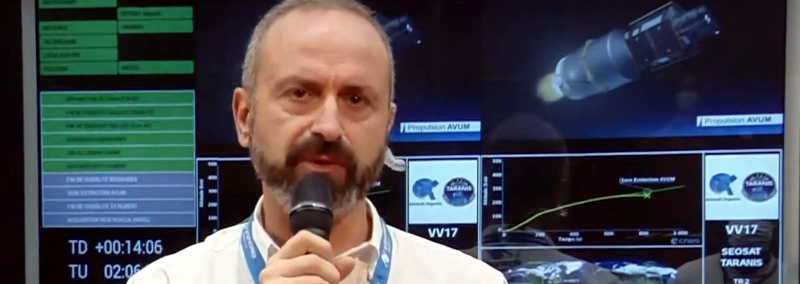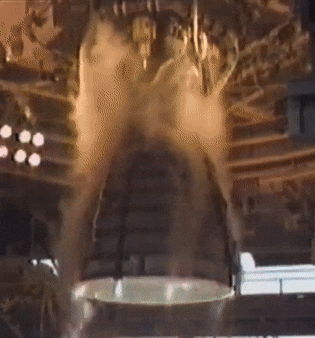On November 17th, a Vega rocket lifted off from French Guiana with its payload of two Earth observation satellites. The booster, coincidentally the 17th Vega to fly, performed perfectly: the solid-propellant rocket engines that make up its first three stages burned in succession. But soon after the fourth stage of the Vega ignited its liquid-fueled RD-843 engine, it became clear that something was very wrong. While telemetry showed the engine was operating as expected, the vehicle’s trajectory and acceleration started to deviate from the expected values.
There was no dramatic moment that would have indicated to the casual observer that the booster had failed. But by the time the mission clock had hit twelve minutes, there was no denying that the vehicle wasn’t going to make its intended orbit. While the live stream hosts continued extolling the virtues of the Vega rocket and the scientific payloads it carried, the screens behind them showed that the mission was doomed.

Unfortunately, there’s little room for error when it comes to spaceflight. Despite reaching a peak altitude of roughly 250 kilometers (155 miles), the Vega’s Attitude Vernier Upper Module (AVUM) failed to maintain the velocity and heading necessary to achieve orbit. Eventually the AVUM and the two satellites it carried came crashing back down to Earth, reportedly impacting an uninhabited area not far from where the third stage was expected to fall.
Although we’ve gotten a lot better at it, getting to space remains exceptionally difficult. It’s an inescapable reality that rockets will occasionally fail and their payloads will be lost. Yet the fact that Vega has had two failures in as many years is somewhat troubling, especially since the booster has only flown 17 missions so far. A success rate of 88% isn’t terrible, but it’s certainly on the lower end of the spectrum. For comparison, boosters such as the Soyuz, Falcon 9, and Atlas have success rates of 95% or higher.
Further failures could erode customer trust in the relatively new rocket, which has only been flying since 2012 and is facing stiff competition from commercial launch providers. If Vega is to become the European workhorse that operator Arianespace hopes, figuring out what went wrong on this launch and making sure it never happens again is of the utmost importance.
Mixed Up Vectoring
Within hours, Arianespace and the European Space Agency (ESA) had already launched an investigation into the loss of the vehicle. These investigations often take weeks or even months to come to a conclusion, but in this case, the public didn’t need to wait nearly so long. By the next day, Arianespace put out a press release explaining that an issue with the thrust vector control (TVC) system of the RD-843 caused the AVUM to go into an uncontrollable tumble roughly eight minutes after liftoff.

In a call with reporters, Arianespace’s Chief Technical Officer Roland Lagier further explained that investigators believe cables connecting two of the TVC actuators was mistakenly swapped during final assembly of the AVUM. The end result is that the motion of the engine’s nozzle was the opposite of what was commanded by the avionics, and that when onboard systems tried to correct the issue, it only made things worse.
He clarified there was no inherent problem with the AVUM or its RD-843 engine, and that this was simply a mistake which hadn’t been caught in time, “This was clearly a production and quality issue, a series of human errors, and not a design one.” The solution therefore would be more stringent post-assembly checks, and likely changes to the cabling that would make it difficult or impossible to repeat the same mistake in the future.
The ESA still needs to verify the findings of Arianespace’s internal investigation, but it’s rumored that close-out images taken of the AVUM during assembly visually confirm the theory actuators were incorrectly wired. While clearly an embarrassing oversight, being able to attribute the failure to human error means that upcoming Vega launches will likely continue as planned.
This Side Up
Readers who may be experiencing a twinge of déjà vu at this point are likely remembering the Russian Proton-M rocket that failed due to very similar circumstances back in 2013. In that case a worker mistakenly installed several angular velocity sensors upside down, providing the booster’s avionics with invalid data. Unprepared for the possibility of such conflicting positional information, the flight control system attempted to correct the situation by commanding the TVC system to make a series of increasingly aggressive maneuvers.

At 23 seconds after liftoff, the Proton-M had completely inverted itself and was pointing downwards. Unfortunately, the flight termination system was designed so that the first stage engines couldn’t be shutdown before 40 seconds into the flight. This feature was in place to help ensure the vehicle had fully cleared the launch complex in the event of an early abort, but in this case, it meant the flight controllers could only watch helplessly as the rocket dove towards the ground at full power.
Investigators examined the debris and confirmed that the angular velocity sensors in question were clearly labeled with arrows that indicated the appropriate installation orientation. Moreover, they were intentionally shaped in such a way that installing them incorrectly was very difficult. In fact, it took so much force to install them improperly that the mounting plate they were attached to was found to have been damaged in the process.
Despite these clear warnings that something was wrong, the junior technician assigned to the task did not alert his superiors to the problem. The mistake also went unnoticed during inspections made by the technician’s supervisor and a quality control specialist, likely due to the fact that the sensors had passed their electrical connectivity tests. The system could detect when sensors hadn’t been wired properly, but it wasn’t designed to verify the data they were producing.
The Human Factor
While we don’t yet know who was responsible for connecting the TVC system of Vega’s AVUM, it wouldn’t come as a surprise to hear it was another junior technician assigned to what was considered a simple task. Unfortunately, there’s no such thing as a simple task when it comes to building an orbital rocket. Equipment worth hundreds of millions of dollars, and potentially even human life, are on the line when the countdown timer hits zero.
Both of these incidents are reminders that when it comes to spaceflight, even the smallest mistakes can have disastrous consequences. In the wake of the Proton-M failure, the Russian government had to conduct a full review of the manufacturing and quality control process that went into each rocket that rolled off the assembly line. The ESA will surely want to conduct a similar review of how the Vega is being built, though it’s too early to say what changes and modifications to existing procedures they may recommend.
In the end, the European Space Agency’s response will likely depend on how difficult it ends up being to incorrectly wire the TVC actuators. Only then will they know if Vega was brought down by a simple accident or gross negligence.
No comments:
Post a Comment